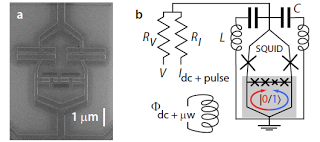a, Scanning electron micrograph (SEM) of a device (qubit and SQUID shown) with identical design parameters as the one measured during this work [1]. b, Schematic. Qubit loop (shaded) and galvanically coupled read-out SQUID. The crosses are Josephson junctions; R, bias resistors; C, shunt capacitances; L, inductances.
Researchers at MIT, MIT Lincoln Laboratory, Japan’s Institute of Physical and Chemical Research and NEC describe a new technique that extends the time a qubit can stay in superposition. The same technique can be used to measure the physical characteristics of qubits that knock them out of superposition in the first place, paving the way to better qubit designs. The previous published record for keeping a superconducting qubit in superposition was less than 10 microseconds and now it is 23 microseconds.
Dwave Systems uses superconducting flux qubits.
Nature Physics – Noise spectroscopy through dynamical decoupling with a superconducting flux qubit
Quantum coherence in natural and artificial spin systems is fundamental to applications ranging from quantum information science to magnetic-resonance imaging and identification. Several multipulse control sequences targeting generalized noise models have been developed to extend coherence by dynamically decoupling a spin system from its noisy environment. In any particular implementation, however, the efficacy of these methods is sensitive to the specific frequency distribution of the noise, suggesting that these same pulse sequences could also be used to probe the noise spectrum directly. Here we demonstrate noise spectroscopy by means of dynamical decoupling using a superconducting qubit with energy-relaxation time T1=12 μs. We first demonstrate that dynamical decoupling improves the coherence time T2 in this system up to the T2=2 T1 limit (pure dephasing times exceeding 100 μs). The characterization of environmental noise has broad utility for spin-resonance applications, enabling the design of optimized coherent-control methods, promoting device and materials engineering, and generally improving coherence
Not only do the microwave pulses extend the qubit’s lifetime, but in an actual quantum computer, they would also instruct the qubits in the execution of their error-correcting code. The complexity of that code would vary according to the algorithm that the quantum computer is running, but it would probably have somewhere between 1,000 and 10,000 separate instructions. In the Nature Physics paper, the researchers report hitting their qubit with 250 microwave pulses. They say, however, that since the experiments reported in the paper, they’ve refined their system so that they can get in about 1,000 pulses before their qubit falls out of superposition.
15 pages of supplemental material at Nature Physics
If you liked this article, please give it a quick review on ycombinator or StumbleUpon. Thanks

Brian Wang is a Futurist Thought Leader and a popular Science blogger with 1 million readers per month. His blog Nextbigfuture.com is ranked #1 Science News Blog. It covers many disruptive technology and trends including Space, Robotics, Artificial Intelligence, Medicine, Anti-aging Biotechnology, and Nanotechnology.
Known for identifying cutting edge technologies, he is currently a Co-Founder of a startup and fundraiser for high potential early-stage companies. He is the Head of Research for Allocations for deep technology investments and an Angel Investor at Space Angels.
A frequent speaker at corporations, he has been a TEDx speaker, a Singularity University speaker and guest at numerous interviews for radio and podcasts. He is open to public speaking and advising engagements.


